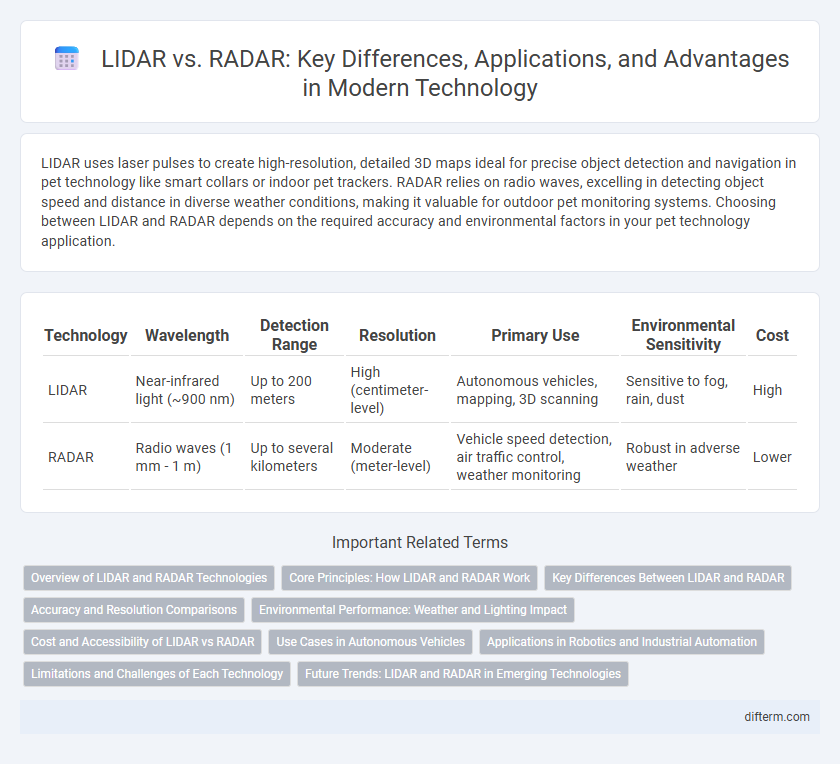LIDAR uses laser pulses to create high-resolution, detailed 3D maps ideal for precise object detection and navigation in pet technology like smart collars or indoor pet trackers. RADAR relies on radio waves, excelling in detecting object speed and distance in diverse weather conditions, making it valuable for outdoor pet monitoring systems. Choosing between LIDAR and RADAR depends on the required accuracy and environmental factors in your pet technology application.
Table of Comparison
| Technology | Wavelength | Detection Range | Resolution | Primary Use | Environmental Sensitivity | Cost |
|---|---|---|---|---|---|---|
| LIDAR | Near-infrared light (~900 nm) | Up to 200 meters | High (centimeter-level) | Autonomous vehicles, mapping, 3D scanning | Sensitive to fog, rain, dust | High |
| RADAR | Radio waves (1 mm - 1 m) | Up to several kilometers | Moderate (meter-level) | Vehicle speed detection, air traffic control, weather monitoring | Robust in adverse weather | Lower |
Overview of LIDAR and RADAR Technologies
LIDAR (Light Detection and Ranging) utilizes laser pulses to measure distances by calculating the time it takes for light to reflect off objects, providing high-resolution 3D maps essential for autonomous vehicles and topographic mapping. RADAR (Radio Detection and Ranging) employs radio waves to detect objects' range, velocity, and angle, excelling in adverse weather conditions and long-range detection for applications like aviation and maritime navigation. Both technologies complement each other by combining LIDAR's precision spatial data with RADAR's robust, all-weather detection capabilities.
Core Principles: How LIDAR and RADAR Work
LIDAR operates by emitting laser pulses and measuring the time it takes for the reflected light to return, enabling precise 3D mapping and distance measurement. RADAR uses radio waves to detect objects by transmitting signals and analyzing the reflected radio frequency waves, excelling in long-range detection and speed measurement. Both technologies rely on wave reflection principles but differ in wavelength, resolution, and application sensitivity.
Key Differences Between LIDAR and RADAR
LIDAR uses laser pulses to generate high-resolution 3D maps by measuring the time it takes for light to return, offering precise distance and shape detection. RADAR employs radio waves to detect objects and measure speed, performing effectively in adverse weather conditions with longer range but lower spatial resolution. The key differences lie in wavelength, accuracy, range, and sensing environment adaptability, making LIDAR optimal for detailed mapping and RADAR suited for robust object detection.
Accuracy and Resolution Comparisons
LIDAR technology offers superior accuracy with resolution capabilities up to a few centimeters, enabling detailed 3D mapping and precise object detection. RADAR, while less precise with resolution generally measured in meters, excels in detecting objects at longer ranges and through adverse weather conditions. The choice between LIDAR and RADAR hinges on balancing high-resolution spatial accuracy against reliability in challenging environments.
Environmental Performance: Weather and Lighting Impact
LIDAR systems provide high-resolution 3D imaging but are significantly impaired by adverse weather conditions such as heavy rain, fog, or snow, which scatter laser pulses and reduce accuracy. RADAR technologies utilize radio waves that penetrate fog and precipitation more effectively, maintaining reliable detection and ranging capabilities in diverse environmental conditions. Consequently, RADAR outperforms LIDAR in maintaining consistent performance during poor lighting and inclement weather, making it preferable for all-weather autonomous vehicle navigation.
Cost and Accessibility of LIDAR vs RADAR
LIDAR systems typically have higher costs due to their complex laser and sensor components, limiting accessibility primarily to specialized industries like autonomous vehicles and surveying. RADAR, benefiting from mature technology and mass production for military and automotive applications, remains more affordable and widely accessible. This cost difference drives RADAR's dominance in cost-sensitive markets while LIDAR advances in precision-demanding sectors.
Use Cases in Autonomous Vehicles
LIDAR provides high-resolution 3D mapping essential for precise object detection and navigation in autonomous vehicles, enabling accurate environment perception even in complex scenarios. RADAR excels in detecting objects at longer ranges and performs reliably under adverse weather conditions such as fog, rain, or snow, complementing LIDAR's limitations. Autonomous vehicle systems often integrate both LIDAR and RADAR to enhance robustness, combining LIDAR's detailed spatial imaging with RADAR's superior range and weather resilience.
Applications in Robotics and Industrial Automation
LIDAR technology provides high-resolution 3D mapping essential for precise navigation and obstacle detection in autonomous robots, enhancing tasks like warehouse management and delivery. RADAR excels in detecting objects in harsh environmental conditions such as dust, fog, or rain, making it ideal for industrial automation systems monitoring moving machinery or vehicle speed. Integrating LIDAR and RADAR enables robust sensor fusion, improving reliability and efficiency in complex robotic and automation applications.
Limitations and Challenges of Each Technology
LIDAR faces limitations such as reduced effectiveness in adverse weather conditions like fog, rain, and snow, which scatter or absorb laser pulses, leading to decreased accuracy and range. RADAR systems struggle with lower resolution due to longer wavelengths, making it difficult to detect smaller or closely spaced objects, and often produce more noise and false positives in cluttered environments. Both technologies encounter challenges in cost, power consumption, and integration complexity, impacting their deployment in applications like autonomous vehicles and remote sensing.
Future Trends: LIDAR and RADAR in Emerging Technologies
LIDAR and RADAR are rapidly evolving to support advancements in autonomous vehicles, robotics, and smart cities, with LIDAR offering higher-resolution 3D mapping while RADAR excels in long-range object detection under adverse weather conditions. Integration of AI algorithms and sensor fusion techniques is enhancing the accuracy and reliability of both technologies, enabling more sophisticated navigation and situational awareness systems. Future trends highlight miniaturization, cost reduction, and increased energy efficiency, driving widespread adoption across consumer electronics, drones, and industrial automation.
LIDAR vs RADAR Infographic

 difterm.com
difterm.com